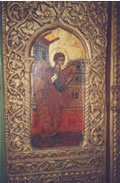|
 14/11/2006
14/11/2006
The wood sculptured works
The wood sculptured works that were created in all the regions where the Tournovo wood travelled were mainly ecclesiastical such as the iconostases, despotic thrones, pulpits etc., for the liturgical needs of the churches, but also for decorative reasons.
 read more
read more
|
|
 14/11/2006
14/11/2006
Iconostases
The Tournovo wood sculptors in their art initially followed the centuries old Byzantine tradition, where the iconostases were mainly made of marble. Thereafter, during the post Byzantine period, the wood sculptors followed the new models. The norm became wood sculptured iconostases, which generally exhibited a tripartite division in the height, which is typologically different.
 read more
read more
|
|
 14/11/2006
14/11/2006
Despotic thrones
Following the fall of Constantinople the construction of new and large churches was not permitted. On the contrary, during the years of the Turkish occupation the demolition of churches was common, at least in the early years, and for that reason the thrones were absent from most churches or have survived in few churches.
 read more
read more
|
|
 14/11/2006
14/11/2006
Pulpits
Like the iconostases and the Despotic thrones, so too the pulpit constituted an inseparable section in the liturgical life of the church.
 read more
read more
|
|
 14/11/2006
14/11/2006
Icon stands
In order to resolve the problem of honouring the saints or the religious events of the churches that had been demolished, it has been mentioned that they transferred the venerated icons on the iconostases, together with the other Despotic icons or they adapted suitable icon stands for these, as for example at the church of the Repose of the Virgin Mary at Stoupaina or they adapted icon stands to the side walls of the church next to the iconostasis or even at rear section of the Despotic thrones, as for example at the church of Aghios Nikolaos at Tsepelovo, etc.
 read more
read more
|
|
|
 14/11/2006
14/11/2006
The lecterns
The lecterns also exist in the churches for the liturgical needs. In order that these may better serve the chanters, they have also taken various shapes; consequently we have observed a variety in their structure, technique and decoration.
 read more
read more
|
|
 14/11/2006
14/11/2006
The monstrance
The monstrance is a sacred vessel within which is preserved the pre sanctified Consecrated bread for the urgent needs of the faithful (situations with the ill, the terminally ill, etc.).
 read more
read more
|
|
 14/11/2006
14/11/2006
Candelabrum – candle sticks and candle holders
Amongst the many liturgical objects in the churches, for the use of the faithful there are also the candle sticks or candle holders (candelabra), on which to support the candles.
 read more
read more
|
|
 14/11/2006
14/11/2006
Ripidia – cherubim
It is worth noting that the wood sculptors were not restricted by the construction of magnificent and impressive works, but were also occupied with small objects, such as the cherubim, which were necessary for the liturgical needs of the churches.
 read more
read more
|
|

